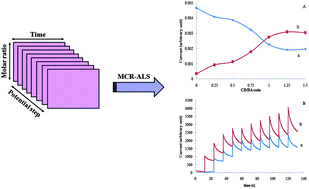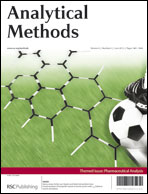In this article, the analytical information obtained from the chronoamperometric data of a weak host–guest complexation was analyzed by multivariate curve resolution-alternative least square (MCR-ALS) as a powerful chemometrics method. As a model system, the complexation of dopamine with β-cyclodextrin was investigated. Whilst the voltammetric behavior of dopamine does not change significantly upon complexation, its chronoamperogram is changed due to the formed complex. The analysis was performed by titrating dopamine (guest) with variable amounts of β-cyclodextrin (host). In each mole ratio of host : guest, the solution was subjected to a potential step experiment, where in each step the current was measured as a function of time. Thus, for each potential a two-fold array of current data with molar ratio in one direction and time in another direction (data matrix) was obtained. The data matrices collected at different potentials were simultaneously analyzed by MCR-ALS to earn thermodynamic parameters (e.g., stoichiometric ratio and formation constant) of cyclodextrin–dopamine complex. This is the first report of simultaneous analysis of potential step-chronoamperometric data matrices by MCR-ALS.

You have access to this article
 Please wait while we load your content...
Something went wrong. Try again?
Please wait while we load your content...
Something went wrong. Try again?


 Please wait while we load your content...
Please wait while we load your content...